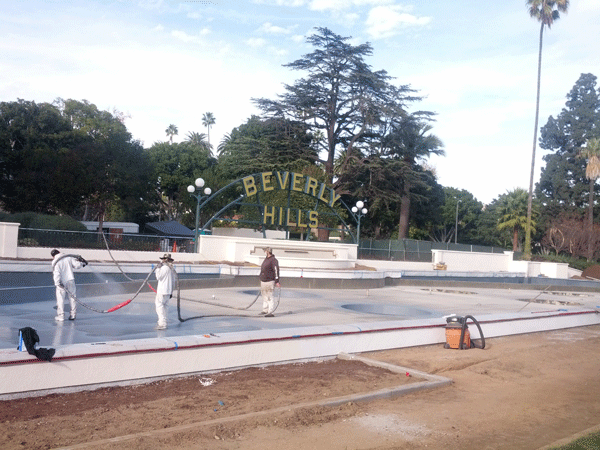Beverly Hills, California, is known as a town where the rich and famous live, shop, and play. It goes without saying that appearances are important in this high-profile community, so when the water feature in front of the iconic Beverly Hills sign began looking a bit worse for the wear, city officials took notice. “The water feature is on a green belt along Santa Monica Boulevard and is very visible. The existing pond was not in good shape for a variety of reasons, not the least of which was age. It was not restorable so it was gutted, the concrete was removed, and new concrete was poured,” explained Donald Dancey, president of Innovative Painting and Waterproofing.
According to Dancey, he and his crew were recommended by D7 Consulting out of Newport Beach, California, to coat the concrete pond with a polyurea coating system. “The concrete pour was done by California Pools. We waited 30 days for the concrete to cure, and then it was time to perform the surface preparation and apply the Freedom Chemical Corporation coatings to the broom finished concrete substrate,” said Dancey.
Getting Started
The eight-member Innovative crew began the 8,000-square-foot (743.2 m²) project by pressure washing the concrete with a Graco 5,000 psi (34.5 MPa) machine. Then they shotblast the substrate with a Blastrac machine to achieve the International Concrete Repair Institute (ICRI) Concrete Surface Profile (CSP) 4–6.
Next, the Innovative crew installed Freedom Tuff 5145 polyurea caulking around all pipe penetrations and a 3/4-inch (1.9 cm) camp bead of caulking on all inside corners of the concrete. “We used a 20-ounce [567.0 g] caulking gun with sausages to install the polyurea caulking,” said Dancey.
At this point, the brand-new concrete substrate was prepped and ready to receive the Freedom Tuff 6160 epoxy primer, a coating with zero volatile organic compounds (VOC), 100 percent solids, and high strength. The crew dipped and rolled the primer in two layers at approximately 5–6 mils (127.0–152.4 microns) each. “Right after we applied the second coat of the primer, we broadcast #20 Monterey [non-silica] sand at 9–11 psi [62.1–75.8 kPa] into the wet coating. This was an important step as the sand helps create a greater mechanical bond for the application of the polyurea,” explained Dancey. While the primer was specially formulated to be used in conjunction with the polyurea body coat, the existence of a better mechanical bond improved the overall adhesion of the coating system.
Dancey also pointed out that the primer was not applied all at once but over the course of the project, depending on what part of the pond the crew was working on at the time. “The primer has a 24-hour recoat window, so we had to be very aware of that as we were working,” said Dancey.
Polyurea for the Pond
Once a section of the water feature had been primed, the crew applied the Freedom Tuff 2202 polyurea using a Graco HXP3 Reactor pump and a Fusion gun with a 42:42 mix chamber. Freedom Tuff 2202 is a two-component, 100 percent pure aromatic polyurea that is flexible, abrasion- and impact-resistant, and forms a continuous and seamless membrane.
The Freedom Tuff 2202 polyurea was sprayed at a thickness of approximately100 mils (2,540.0 microns). This thickness was achieved in two passes that were sprayed during the same day. “It took us three days total to spray the polyurea. Once again, we had to really pay attention to the recoat window,” said Dancey. According to the material data sheet, Freedom 2202 polyurea has a six-hour recoat window before sanding and re-priming is necessary.
Another important aspect of the project was making sure that the pipes of the water feature were protected by the coating system. “We added a termination band (like a stainless steel radiator hose clamp) and then buried that band in the coating to keep it from peeling off that area,” explained Dancey.
Safe and Quiet
Throughout the duration of this high-profile coating endeavor, safety was a top priority. The crew wore vests, hard hats, boots, gloves, and safety glasses, as well as North half-face charcoal respirators and Tyvek suits when spraying the polyurea.
Keeping the workers safe was a continuous job, as was overcoming the challenging moments encountered during its three-week duration.

According to Dancey, the biggest challenge was keeping within the strict work times mandated by the city of Beverly Hills. “The city maintains a noise ordinance that only allows construction work Monday through Friday from the hours of 8 a.m. to 5 p.m. Since all of us had a commute to get to the jobsite, this was pretty challenging, especially considering rush-hour traffic. Many days, members of the crew would arrive at 6:30 a.m. before traffic was too heavy and wait around until work could begin,” said Dancey.
The strict work hours also proved challenging as far as logistics and scheduling. The crew had to make sure that everything was ready to go promptly at 8 a.m. and that they were finished at 5 p.m. without fail.
Camera-Ready Results
For Dancey and his crew, the coating of the new concrete water feature in Beverly Hills was a success in large part because of the materials used. “The Freedom caulking, primer, and polyurea all work together to form a very functional coating system. And the polyurea coating in particular was one of the main reasons that this job went so smoothly — it was the right product for the job. It will stand up to the plant growth in the pond and will also do well with any ground movement, as it is flexible and durable,” said Dancey. Lights, camera, action!
